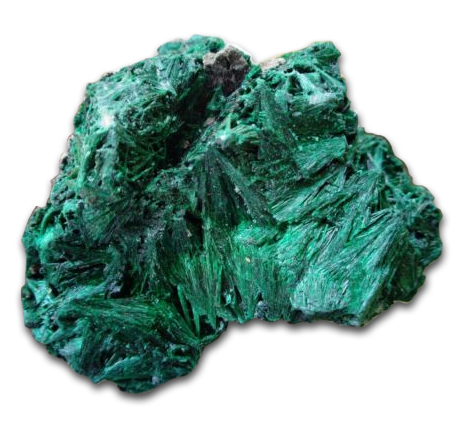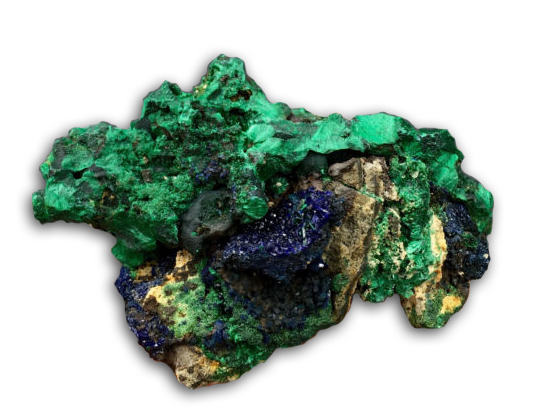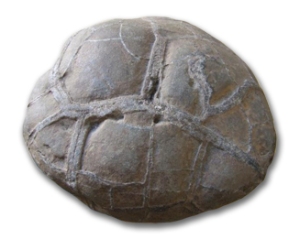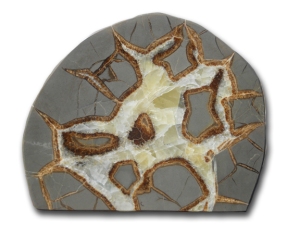Tag Archives: rock
Hematite
[Guest Author Matt Doyle]
Hematite, famous modernly for the steel-grey jewelry often made from it, is more commonly a rust-red ore when found in mining iron[1]. A iron oxide (Fe2O3), hematite’s name comes from haema, the Greek word for blood[2], and most of its direct historical impact comes from that red form. While hematite is incredibly common – the most common form of iron ore[3] – even in ancient times it was appreciated for itself, and not only for the metal it could produce. In modern times, magnets are used to harvest hematite from mine tailings.
 Red hematite most commonly possesses an earthy luster, appearing anywhere from rust-colored to Powdered red hematite is also known as rouge. Perhaps most famous as a cosmetic used for centuries to redden the skin, it is the same substance as jeweler’s rouge, used to polish metal and gemstones, and also frequently used to help strop a barber’s straight razor. Red ochre and yellow ochre painting pigments also owe their color to a mixture of red hematite and clay – unhydrated in red ochre, and hydrated in yellow[4]. Maybe most strikingly, hematite is the basis of red chalk, and red chalk drawings have many prominent places in human history and the history of art, including the sketches of Leonardo DaVinci, the body painting of corpses in paleolithic cultures one hundred and sixty to eighty thousand years ago[5], and numerous cave paintings dating back as much as forty thousand years[6]. Red chalk mines dates back as far as 5000 BCE.
Red hematite most commonly possesses an earthy luster, appearing anywhere from rust-colored to Powdered red hematite is also known as rouge. Perhaps most famous as a cosmetic used for centuries to redden the skin, it is the same substance as jeweler’s rouge, used to polish metal and gemstones, and also frequently used to help strop a barber’s straight razor. Red ochre and yellow ochre painting pigments also owe their color to a mixture of red hematite and clay – unhydrated in red ochre, and hydrated in yellow[4]. Maybe most strikingly, hematite is the basis of red chalk, and red chalk drawings have many prominent places in human history and the history of art, including the sketches of Leonardo DaVinci, the body painting of corpses in paleolithic cultures one hundred and sixty to eighty thousand years ago[5], and numerous cave paintings dating back as much as forty thousand years[6]. Red chalk mines dates back as far as 5000 BCE.
Grey hematite, unlike the “bloodstone” variety that gave it its name, has a metallic luster, and can appear almost like a dark mirror when sufficiently polished. Faceted, it appears nearly black, and smooth, it has a gray, lustrous tone similar to a black pearl. Used as a gemstone in jewelry, for gilding, or for carved intaglios, it was especially popular in Victorian England, and is still used today, in part because it is common enough to be relatively affordable. In its more jewel-like form, it has been sought after for over two millennia, since the Etruscans found deposits of it on the island of Elba.
 Outside of iron mines, hematite is commonly found in banded iron formations, hot springs, clay banks, and other places where iron interacts with water[7] (or more rarely, without water, as a result of volcanic activity). Whether grey or red, it always leaves a red streak[8] (and a grey stone leaving a red streak is often striking and startling to students in the lab seeing it for the first time). Hematite often contains enough inclusions of magnetite to appear attracted to magnets, however, hematite itself is only weakly ferromagnetic when encountered at room temperature. Its specific magnetic properties are variable in peculiar ways depending on the scale of the hematite crystal, and its small magnetic moment, as well as the temperatures at which it transitions from antiferromagnetic to paramagnetic, have been the subject of much discussion since the 1950s (and as such, could make up an essay – or many scholarly papers – of their own).
Outside of iron mines, hematite is commonly found in banded iron formations, hot springs, clay banks, and other places where iron interacts with water[7] (or more rarely, without water, as a result of volcanic activity). Whether grey or red, it always leaves a red streak[8] (and a grey stone leaving a red streak is often striking and startling to students in the lab seeing it for the first time). Hematite often contains enough inclusions of magnetite to appear attracted to magnets, however, hematite itself is only weakly ferromagnetic when encountered at room temperature. Its specific magnetic properties are variable in peculiar ways depending on the scale of the hematite crystal, and its small magnetic moment, as well as the temperatures at which it transitions from antiferromagnetic to paramagnetic, have been the subject of much discussion since the 1950s (and as such, could make up an essay – or many scholarly papers – of their own).
[1] https://en.wikipedia.org/wiki/Hematite
[2] http://www.mindat.org/min-1856.html
[3] http://geology.com/minerals/hematite.shtml
[4] http://www.mineralszone.com/minerals/ochre.html
[5] https://en.wikipedia.org/wiki/Pinnacle_Point
[6] http://www.eurekalert.org/pub_releases/2007-10/asu-rfe101207.php

Grit – Treasures of Sea & Earth
Treasures of Sea & Earth supply grit for your rock tumbling needs. For club discounts, please see the Member page. For more information, please check out http://treasuresofseaandearth.com/ Currently available:
400 5lb: $30.00 1lb: $6.00
600 5lb: $30.00 1lb: $6.00
46/70 5lb: $18.80 1lb: $4.00
120/220 5lb: $21.00 1lb: $4.20
Tin Oxide 5lb: $145.00 1lb: $29.00
Tripoli Powder 5lb: $18.80 1lb: $4.00
Plastic pellets 1lb: $4.20

Malachite

Fibrous malachite
Malachite is an intense green colored, copper carbonate mineral. Instead of being a solid color, it is often banded in shades of green. While it can form tabular and twinned crystals, it is more often seen as botryoidal masses, or stalactitic, with a fibrous banded structure or crusts. Malachite can commonly be found with azurite. It has a hardness of 3.5-4 – soft enough to carve readily, yet still taking a polish. The stone is used for decoration, ornamentation, and jewelry. It can also be crushed and made into a green pigment. It was originally worn to ward off evil spirits.
Malachite comes from many locations, including Russia, Africa, Australia,

Malachite with azurite
Brazil, and Arizona. It was named after the Greek word “mallows”, alluding to its leafy green color. It has also been called Atlas ore and Green Copper.
The chemical formula is: Cu2CO3(OH)2
http://www.minerals.net/mineral/malachite.aspx
http://www.mindat.org/min-2550.html
Pellant, Chris. Rocks and Minerals. New York: Dorling Kindersley, 1992. Print. Pg. 105.
Busbey, Arthur Bresnahan. Rocks & Fossils. Alexandria, VA: Time Life, 1996. Print. Pg. 174
42nd Annual Rock Show – Local News
Fulgurite
 Not truly a mineral or a fossil, fulgurite is sometimes referred to as petrified lightning. The word comes from Latin (fulgur = lightning), and is amorphous “lechatelierite” silica glass. When lightning or electricity strikes a conductive surface, the temperature can skyrocket to at least 2,950F and melt surrounding silica or quartz leaving behind a glass tube. Lechatelierite can also be formed when a meteor impacts the ground, or during volcanic explosions.
Not truly a mineral or a fossil, fulgurite is sometimes referred to as petrified lightning. The word comes from Latin (fulgur = lightning), and is amorphous “lechatelierite” silica glass. When lightning or electricity strikes a conductive surface, the temperature can skyrocket to at least 2,950F and melt surrounding silica or quartz leaving behind a glass tube. Lechatelierite can also be formed when a meteor impacts the ground, or during volcanic explosions.
They vary in shape, size, and color, and can be very fragile. Larger pieces have been recorded between 13-30 feet in length. Their shape mimics the path the electrical charge took.
Septarian nodule (concretion)
A “concretion” refers to a type of mineral deposit, where layers of precipitated minerals are attracted to a starting nucleus (such as shell or bone) – much like how a pearl forms. Generally this occurs in water-rich environment, where there are minimal restrictions or obstructions to the concretion growth, resulting in a round shape. Numerous concretions may start growing near each other, then merge to form larger masses.
These particular concretions contain angular cracks and cavities. The word “septarian” comes from the Latin word septum, meaning a wall or partition, referring to the cracks riddling through these concretions. It is believed the cracks are formed from shrinkage of material – where the outside deposited material is denser or hard, while the innermost material is softer, which shrinks and cracks over time. These cracks are then filled with precipitate minerals such as calcite or siderite.
Septarian nodules are common in the northeastern part of North Dakota, near the Pembina Gorge. As they weather out of the ground, the softer, original concretionary material erodes faster than the cracks, giving the nodule a turtle-shell like appearance. These are often mistaken for fossils.
http://en.wikipedia.org/wiki/Concretion
Buchanan, Rex C., Tolsted, Laura L., and Swineford, Ada, 1986, Kansas Rocks and Minerals: Kansas Geological Survey, Educational Series 2, 60 p.
Teredo-bored Petrified Wood
Teredo-bored petrified wood is North Dakota’s state fossil. It is found in 60 million year old Paleocene deposits, found in the southwestern area of the state. These are areas that were covered by the Cannonball Sea, now exposed at the surface. Before fossilizing, it was drift wood (ginkgo, bald cypress, metasequoia, etc.) that had been drilled (bored) into by small worm-like clams (Teredo), creating a Swiss-cheese effect.
Part of the fossilization included filling the borings with sediment or crystals, often seen as a different color or texture. If slabbed, the tiny clams can even be seen in cross section as little white crescents. The clams, also called shipworms, still pose a problem for wooden boats or docks today.
Teredo-bored petrified wood was adopted in 1967, and added to the Smithsonian Institution’s mineral collection. The selection was brought to the legislature by R. W. Carlson of Bismarck, former present of the Central Dakota Gem and Mineral Society, and H. A. Brady of Mandan. State Represenative W. G. Sanstead of Minot proposed the state fossil selection in House Bill 933.
https://www.dmr.nd.gov/ndgs/outofprint/NewsLetters/1993Spring.pdf (publication page 4 & 5)
http://ndstudies.gov/state_fossil
https://www.dmr.nd.gov/ndfossil/kids/FIND%20ISSUE%2011%20small.pdf
Rhodochrosite
 Rhodochrosite is a translucent to transparent, ranging in colors from white, to pink, to red. It is a manganese carbonate, found in hydrothermal veins alongside copper, silver, and lead, and can be used as a manganese ore. When exposed to air, rhodochrosite tends to form a dark rind as it oxidizes. It is generally a massive, nodular, or botryoidal
Rhodochrosite is a translucent to transparent, ranging in colors from white, to pink, to red. It is a manganese carbonate, found in hydrothermal veins alongside copper, silver, and lead, and can be used as a manganese ore. When exposed to air, rhodochrosite tends to form a dark rind as it oxidizes. It is generally a massive, nodular, or botryoidal  form, however the rare transparent rhombohedral crystals can also be found. It has a hardness of 3.5-4 on the Mohs scale, has a white streak, and is soluble in warm hydrochloric acid. Due to its soft nature, and beautiful commonly banded colors, this mineral is often used as a carving medium, but rarely faceted.
form, however the rare transparent rhombohedral crystals can also be found. It has a hardness of 3.5-4 on the Mohs scale, has a white streak, and is soluble in warm hydrochloric acid. Due to its soft nature, and beautiful commonly banded colors, this mineral is often used as a carving medium, but rarely faceted.  Its chemical composition is MnCO3. Its name comes from Greek, literally meaning rose-colored.
Its chemical composition is MnCO3. Its name comes from Greek, literally meaning rose-colored.
Pellant, Chris. Rocks And Minerals. New York, Dorling Kindersley, Inc., 2000. Pg 100.
Busbey III, Arthur B. Rocks & Fossils. Time Life Books, 1997. Pg 170.
Chalcopyrite
Chalcopyrite is a brassy-colored, copper iron sulfide. It was named by Johann Friedrich Henckel in 1725, from the Greek “chalkos” meaning copper, and “pyrites” meaning to strike fire. It has a green-black streak, yet tarnishes in a variety of iridescent purple, blue, and red. It sometimes goes by the term “peacock rock”. It is often mistaken for pyrite, but is a softer 3.5-4 on the Mohs scale. It is brittle, and can shatter if struck. It has poor cleavage, and fractures unevenly. It can be found in tetragonal crystal form, massive, and even botryoidal.
This mineral has been mined as a copper ore for thousands of years. Copper mixed with zinc creates brass, but mixed with tin creates bronze – a metal used in tools for ages. It is very common in sulfide veins, high-temperature hydrothermal veins, igneous dikes, and more. When oxidized, or weathered, chalcopyrite may form malachite, azurite, cuprite, and other minerals.
Group: Sulfide. The chemical formula is CuFeS2.
Klein, Cornelis and Cornelius S. Hurlbut, Jr., Manual of Mineralogy, Wiley, 20th ed., 1985, pp. 277 – 278
http://en.wikipedia.org/wiki/Chalcopyrite
http://www.mindat.org/min-955.html
http://www.esci.umn.edu/courses/1001/minerals/chalcopyrite.shtml









